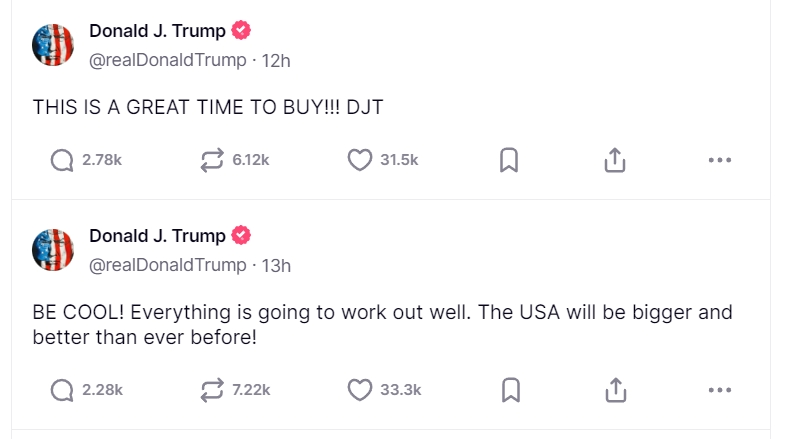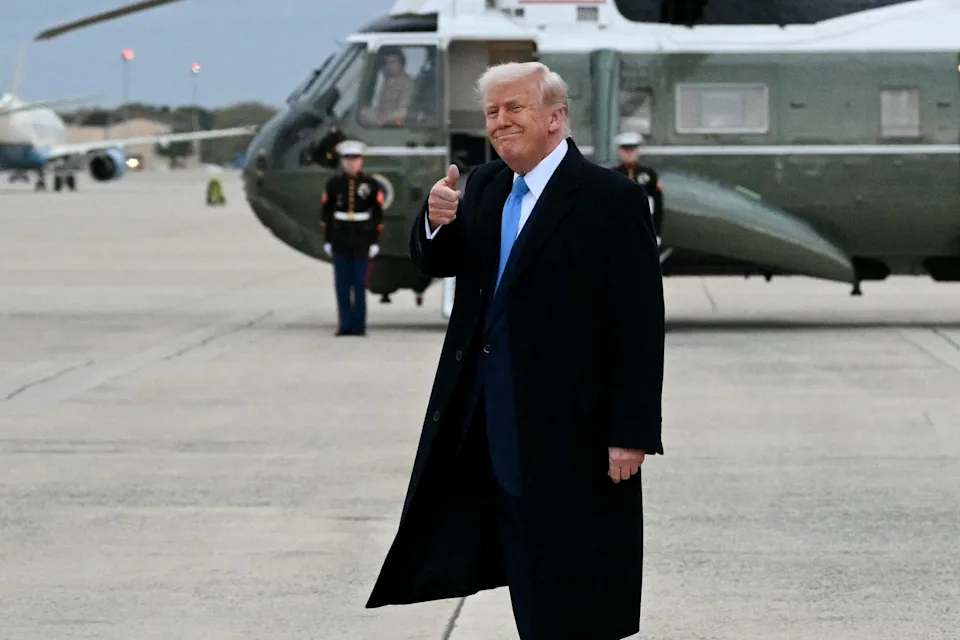Does Trump's call for investors to surge after buying U.S. stocks is market manipulation?
This chain of "the president calls for orders, policy implementation, and market skyrocketing" appears to show administrative efficiency on the surface, but actually implies the risk of information asymmetry.
On April 10, a few minutes after the U.S. stock market opened, U.S. President Trump released a short but highly impactful message through his own social media platform Truth Social: "Now is a good time to buy!!!DJT”。

This tweet not only directly drove the stock prices of multiple target companies, including the S & P 500 Index ETF, Tesla and Trump's Media Technology Group, to soar, but also caused the time lag between it and the subsequent "90-day suspension of reciprocal tariffs" policy, which triggered a fierce controversy about "market manipulation."On the same day, the S & P 500 index closed up 9.52%, the largest one-day gain since the 2008 financial crisis. Trump Media Technology Group's share price soared by more than 21%, and the value of its personal shareholding instantly expanded by hundreds of millions of dollars.
"Precise resonance" between policy and market
Within two hours of Trump's tweet, the Office of the U.S. Trade Representative announced a 90-day tariff moratorium on countries and regions that did not impose retaliatory tariffs.This policy directly reversed the previous global market panic caused by "reciprocal tariffs."Take the SPDR S & P 500 Index ETF as an example. Its price soared from US$494.11 when Trump shouted to US$548.62, a one-day increase of 11%; Tesla's share price rebounded 22% against the trend in the controversy over spending cuts by the Musk Government's Department of Efficiency (DOGE), the largest increase since 2013.This chain of "the president calls for orders, policy implementation, and market skyrocketing" appears to show administrative efficiency on the surface, but actually implies the risk of information asymmetry.Although Trump denied deliberately manipulating the market on April 7, saying that the market "has to take medicine when it is sick," the coincidence at this time still raises questions about whether he used his position to release policy signals in advance.
Game in legal gray areas
Section 10(b) of the U.S. Securities Act clearly prohibits transactions through material non-public information. As a core participant in policy formulation, there is room for legal interpretation of whether the president's remarks constitute "market manipulation."It is worth noting that Trump specifically emphasized "DJT" in his tweet-both his initials and the stock code of the media technology group in which he controls 58%.The stock's trading volume surged 300% that day, and its market value increased by more than US$400 million in a single day. The trust company managed by his son Donald Jr. directly benefited as a major shareholder.This behavior of embedding personal business interests into policy declarations has touched the red line of the U.S. Government Ethics Act regarding conflicts of interest for public officials.Stephanie Avakian, former director of the SEC's Enforcement Division, once pointed out: "When the remarks of public officials can directly affect the price of specific securities, a stricter firewall of information disclosure must be established.”
The Federal Reserve's warnings and market structural risks
In the minutes of the Federal Reserve's interest-rate meeting in March, officials issued a rare collective warning that the Trump administration's tariff policy had caused the economic uncertainty index to rise to a nearly decade-long high, and the risk of "stagflation" in which inflation rose and growth slowed increased.Although the suspension of tariffs temporarily eased market anxiety, the Federal Reserve kept interest rates high at 4.25%-4.5%, and lowered its forecast for GDP growth in 2025 to 1.7%.This policy contradiction is reflected in the fact that short-term stimulus by the executive branch is hedging against the long-term prudence of the monetary authorities.Analysts at Goldman Sachs pointed out that the current valuation of U.S. stocks has deviated from fundamentals. The forward P/E ratio of the S & P 500 index reaches 22.3 times, far exceeding the 15-year average of 16.1 times. The policy-driven rebound may aggravate market vulnerability.
Historical mirror images and institutional flaws
Looking back at history, it is not uncommon for US presidents to intervene in the market.In 1999, Clinton shouted that "now is the best time to invest in technology stocks", pushing the Nasdaq index to exceed 5000 points, but the following year the Internet bubble burst; in 2020, Trump asked the Federal Reserve to "increase water" to support the stock market, which ultimately led to inflation getting out of control in 2023.The particularity of the current incident is that the decision-maker also has the identity of the actual controller of the listed company. This mixing of public and private roles amplifies moral hazard.Brookings Institution research shows that suspected insider trading cases involving White House officials have increased by 240% in the past five years, but the conviction rate is less than 3%, fully exposing the lag in supervision.

·Original
Disclaimer: The views in this article are from the original Creator and do not represent the views or position of Hawk Insight. The content of the article is for reference, communication and learning only, and does not constitute investment advice. If it involves copyright issues, please contact us for deletion.